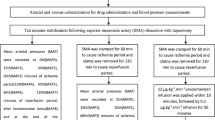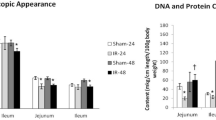Abstract
Objectives
Ischemia–reperfusion is a major event for induction of cellular apoptosis. Apoptosis is due to the activation of death receptor and/or mitochondrial pathways. Mitochondrial permeability transition pore opening is the cause of apoptosis. In our present study, we tried to evaluate the role of flunarizine in ischemia and reperfusion of celiac artery-induced gastric lesion in the rat.
Methods
The therapeutic potential of flunarizine was assessed by measuring the changes in gastric lesion index, biomarker (i.e., thiobarbituric acid reactive substance, reduced glutathione, superoxide dismutase, myeloperoxidase, and total calcium and protein content), and mitochondrial damage (i.e., adenosine triphosphate and deoxyribonucleic acid fragmentation content) in ischemia and reperfusion-induced gastric lesion model.
Results
Medium and higher doses of flunarizine produced a significant (P < 0.05) ameliorative effect which was observed from the assessment of all the above-mentioned parameters (i.e., increase in reduced glutathione, superoxide dismutase and decrease in thiobarbituric acid reactive substance, myeloperoxidase, and total calcium content). Similar results were also obtained from omeprazole and cyclosporine. In the pre-treated group, deoxyribonucleic acid fragmentation pattern has also indicated that a mitochondria-associated anti-apoptotic effect of flunarizine was responsible to prevent the ischemia and reperfusion of celiac artery-induced gastric lesion.
Conclusion
The gastroprotective effect of flunarizine may be produced due to its inactivation potential of mitochondrial permeability transition pore opening associated with anti-oxidative, calcium regulation along with its anti-apoptotic effect.



Similar content being viewed by others

References
Bagdatoglu OT, Polat G, Bagdatoglu C, et al. Effects of peripheral nerve ischemia-reperfusion model on serum cytokine levels. Turk Neurosurg. 2008;18:149–156.
Muthuraman A, Ramesh M, Sood S. Development of animal model for vasculatic neuropathy: Induction by ischemic-reperfusion in the rat femoral artery. J Neurosci Methods. 2010;186:215–221.
Muthuraman A, Sood S. Antisecretary, antioxidative and antiapoptotic effects of montelukast on pyloric ligation and water immersion stress induced peptic ulcer in rat. Prostaglandins Leukot Essent. Fatty Acids. 2010;83:55–60.
Kwiecien S, Brzozowski T, Konturek SJ. Effects of reactive oxygen species action on gastric mucosa in various models of mucosal injury. J Physiol Pharmacol. 2002;53:39–50.
Rugge M, de Boni M, Pennelli G, et al. Gastritis OLGA-staging and gastric cancer risk: a twelve year clinico-pathological follow-up study. Aliment Pharmacol Ther. 2010;31:1104–1111.
Wada K, Montalto MC, Stahl GL. Inhibition of complement C5 reduces local and remote organ injury after intestinal ischemia/reperfusion in the rat. Gastroenterology. 2001;120:126–133.
Stevens CE, Leblond CP. Renewal of the mucous cells in the gastric mucosa of the rat. Anat Rec. 2005;115:231–245.
Droge W. Free radicals in the physiological control of cell function. Physiol Rev. 2002;82:47–95.
Muthuraman A, Jaggi AS, Singh N, et al. Ameliorative effects of amiloride and pralidoxime in chronic constriction injury and vincristine induced painful neuropathy in rats. Eur J Pharmacol. 2008;587:104–111.
Evans SM, Whittle BJR. Role of bacteria and inducible nitric oxide synthase activity in the systemic inflammatory microvascular response provoked by indomethacin in the rat. Eur J Pharmacol. 2003;461:63–71.
Olivares D, Gisbert JP, Pajares JM. Helicobacter pylori infection and gastric mucosal epithelial cell apoptosis. Rev Esp Enferm Dig. 2005;97:505–520.
Fukuyama K, Iwakiri R, Noda T, et al. Apoptosis induced by ischemia-reperfusion and fasting in gastric mucosa compared to small intestinal mucosa in rats. Dig Dis Sci. 2001;46:545–549.
Wada K, Nakajima A, Takahashi H, et al. Protective effect of endogenous PPARgamma against acute gastric mucosal lesions associated with ischemia-reperfusion. Am J Physiol Gastrointest Liver Physiol. 2004;287:G452–G458.
Haworth RA, Hunter DR. The Ca2+ induced membrane transition in mitochondria: II. Nature of the Ca2+ trigger site. Arch Biochem Biophys 1979;195:460–467.
Zoratti M, Szabo I. The mitochondrial permeability transition. Biochim Biophys Acta. 1995;1241:139–176.
Lemasters JJ, Theruvath TP, Zhong Z, et al. Mitochondrial calcium and the permeability transition in cell death. Biochim Biophys Acta. 2009;1787:1395–1401.
Zhou XY, Du DS, Ma XB, et al. The protective mechanism of N-acetylcysteine against ischemia/reperfusion induced gastric injury in rats. Sheng Li Xue Bao. 2010;62:69–72.
Biswas K, Bandyopadhyay U, Chattopadhyay I, et al. A novel antioxidant and antiapoptotic role of omeprazole to block gastric ulcer through scavenging of hydroxyl radical. J Biol Chem. 2003;278:10993–11001.
Muthuraman A, Sood S. Antisecretory, antioxidative and antiapoptotic effects of montelukast on pyloric ligation and water immersion stress induced peptic ulcer in rat. Prostaglandins Leukot Essent Fatty Acids. 2010;83:55–60.
Armstrong JS. The role of the mitochondrial permeability transition in cell death. Mitochondrion. 2006;6:225–234.
Kim JS, He L, Lemasters JJ. Mitochondrial permeability transition: a common pathway to necrosis and apoptosis. Biochem Biophys Res Commun. 2003;304:463–470.
Santi CM, Cayabyab FS, Sutton KG, et al. Differential inhibition of T-type calcium channels by neuroleptics. J Neurosci. 2002;22:396–403.
Spierings EL. Clinical and experimental evidence for a role of calcium entry blockers in the treatment of migraine. Ann N Y Acad Sci. 1988;522:676–689.
Greenberg DA, Carpenter CL, Messing RO. Ethanol induced component of 45 Ca2+ uptake in PC12 cells is sensitive to Ca2+ channel modulating drugs. Brain Res. 1987;410:143–146.
Murai K, Tyler RS, Harker LA, et al. Review of pharmacologic treatment of tinnitus. Am J Otol. 1992;13:454–464.
Konrad T, Bloechle C, Haller G, et al. Verapamil and flunarizine protect the isolated perfused rat liver against warm ischemia and reperfusion injury. Res Exp Med. 1995;195:61–68.
Elimadi A, Bouillot L, Sapena R, et al. Dose-related inversion of cinnarizine and flunarizine effects on mitochondrial permeability transition. Eur J Pharmacol. 1998;348:115–121.
Takei M, Hiramatsu M, Mori A. Inhibitory effects of calcium antagonists on mitochondrial swelling induced by lipid peroxidation or arachidonic acid in the rat brain in vitro. Neurochem Res. 1994;19:1199–1206.
So HS, Park C, Kim HJ, et al. Protective effect of T-type calcium channel blocker flunarizine on cisplatin-induced death of auditory cells. Hear Res. 2005;204:127–139.
Ali BH, Al-Moundhri M, Eldin MT, et al. Amelioration of cisplatin-induced nephrotoxicity in rats by tetramethylpyrazine, a major constituent of the chinese herb Ligusticum wallichi. Exp Biol Med. 2008;233:891–896.
Armstrong JS. The role of the mitochondrial permeability transition in cell death. Mitochondrion. 2006;6:225–234.
Ciancarelli I, Tozzi-Ciancarelli MG, Di Massimo C, et al. Urinary nitric oxide metabolites and lipid peroxidation by products in migraine. Cephalalgia. 2003;23:39–42.
Muthuraman A, Singla SK, Rana A, et al. Reno-protective role of flunarizine (mitochondrial permeability transition pore inactivator) against gentamicin induced nephrotoxicity in rats. Yakugaku Zasshi. 2010 (in press).
Wada K, Kamisaki Y, Kitano M, et al. A new gastric ulcer model induced by ischemia-reperfusion in the rat: role of leukocytes on ulceration in rat stomach. Life Sci. 1996;59:PL295–PL301.
Shay H, Sun DCY, Gruenstein R. A quantitative method for measuring spontaneous gastric secretion in the rat. Gastroenterology. 1954;26:906–1013.
Okhawa H, Ohishi N, Yagi K. Assay for lipid peroxidation in animal tissue by thiobarbituric acid reaction. Analyt Biochem. 1979;95:351–358.
Ellman GL. Tissue sulfhydryl groups. Arch Biochem Biophys. 1959;82:70–77.
Krawisz JE, Sharon P, Stenson WF. Quantitative assay for acute intestinal inflammation based on myeloperoxidease activity: assessment of inflammation in rat and hamster models. Gastroenterology. 1984;87:1344–1350.
Hillegass LM, Griswold DE, Brickson B, et al. Assessment of myeloperoxidase activity in whole rat kidney. J Pharmacol Meth. 1990;24:285–295.
Qiu BS, Pfeiffer CJ, Wu W, et al. Tungstic acid reduced gastric ulceration in stressed rats. J Gastroenterol Hepatol. 1997;12:19–23.
Severinghaus JW, Ferrebee JW. Calcium determination by flame photometry; methods for serum, urine, and other fluids. J Biol Chem. 1950;187:621–630.
Lowry OH, Rosenbrough NJ, Farr AL, et al. Protein measurement with folin phenol reagent. J Biol Chem. 1951;193:265–275.
Paroni R, de Vecchi E, Lubatti L, et al. Influence of the 21-aminosteroid U74389F on ischemia-reperfusion injury in the rat. Eur J Pharmacol. 1995;294:737–742.
Vecchi ED, Lubatti L, Beretta C, et al. Protection from renal ischemia-reperfusion injury by the 2-methylaminochroman U83836E. Kidney Int. 1998;54:857–863.
Moore DD. In Current protocols in molecular biology. In: Ausubel FM, eds. New York: Wiley, 1998:2.1.1–2.1.2.
Huang T, Cheng AG, Stupak H, et al. Oxidative stress-induced apoptosis of cochlear sensory cells: otoprotective strategies. Int J Dev Neurosci. 2000;18:259–270.
Jiang M, Wei Q, Pabla N, et al. Effects of hydroxyl radical scavenging on cisplatin-induced p53 activation, tubular cell apoptosis and nephrotoxicity. Biochem Pharmacol. 2007;73:1499–1510.
Xia HH, Talley NJ. Apoptosis in gastric epithelium induced by Helicobacter pylori infection: implications in gastric carcinogenesis. Am J Gastroenterol. 2001;96:16–26.
Sood S, Muthuraman A. Activity of tacrolimus: an immunosuppressant, in pyloric ligation-induced peptic ulcer in the rat. Yakugaku Zasshi. 2009;129:1523–1528.
Zhang JF, Zhang YM, Yan CD, et al. Neuroregulation mechanism of hypothalamic paraventricular nucleus on gastric-reperfusion injury in rats. Life Sci. 2002;71:1501–1510.
Zhang Z, Yuan Y, Gao H, et al. Apoptosis, proliferation and p53 gene expression of H. pylori associated gastric epithelial lesions. World J Gastroenterol. 2001;7:779–782.
Naito Y, Mizushima K, Yoshikawa T. Global analysis of gene expression in gastric ischemia-reperfusion: a future therapeutic direction for mucosal protective drugs. Dig Dis Sci. 2005;50:S45–S55.
Sahin E, Gumuslu S. Immobilization stress in rat tissues: alterations in protein oxidation, lipid peroxidation and antioxidant defense system. Comp Biochem Physiol C Toxicol Pharmacol. 2007;144:342–347.
Qiao WL, Wang L, Zhang JF, et al. Effects of gastric ischemia-reperfusion on gastric mucosal cellular apoptosis and proliferation in rats. Sheng Li Xue Bao. 2006;58:237–243.
Wang RF, Gagliuso DJ, Podos SM. Effect of flunarizine, a calcium channel blocker, on intraocular pressure and aqueous humor dynamics in monkeys. J Glaucoma. 2008;17:73–78.
So HS, Kim HJ, Lee JH, et al. Flunarizine induces Nrf2-mediated transcriptional activation of heme oxygenase-1 in protection of auditory cells from cisplatin. Cell Death Differ. 2006;13:1763–1775.
Acknowledgments
Thanks to all the faculty members of Rayat Institute of Pharmacy for their encouragement and support for this study.
Conflict of interest
There is no conflict of interest.
Author information
Authors and Affiliations
Corresponding author
Rights and permissions
About this article
Cite this article
Muthuraman, A., Ramesh, M. & Chauhan, A. Mitochondrial Dependent Apoptosis: Ameliorative Effect of Flunarizine on Ischemia–Reperfusion of Celiac Artery-Induced Gastric Lesions in the Rat. Dig Dis Sci 56, 2244–2251 (2011). https://doi.org/10.1007/s10620-011-1607-0
Received:
Accepted:
Published:
Issue Date:
DOI: https://doi.org/10.1007/s10620-011-1607-0



